
Tex-Mex cuisine is a regional American cuisine that originates from the culinary creations of Tejano people. It has spread from border states such as Texas and others in the Southwestern United States to the rest of the country. It is a subtype of Southwestern cuisine found in the American Southwest.

A cooking show, cookery show, or cooking program is a television genre that presents food preparation, often in a restaurant kitchen or on a studio set, or at the host's personal home. Typically the show's host, often a celebrity chef, prepares one or more dishes over the course of an episode, taking the viewing audience through the food's inspiration, preparation, and stages of cooking.

A cookbook or cookery book is a kitchen reference containing recipes.

Thai eggplant is the name for several varieties of eggplant used in Southeast Asian cuisines, most often of the eggplant species Solanum melongena. They are also cultivated in India and Sri Lanka and feature in Sri Lankan cuisine. These golf ball sized eggplants are commonly used in Thai cuisine, Indonesian cuisine, and in Cambodian Cuisine. Some of the cultivars in Thailand are Thai Purple, Thai Green, Thai Yellow, and Thai White.

California cuisine is a food movement that originated in Northern California. The cuisine focuses on dishes that are driven by local and sustainable ingredients with an attention to seasonality and an emphasis on the bounty of the region.

Prahok is a salted and fermented fish paste used in Cambodian cuisine as a seasoning or a condiment. It originated as a way of preserving fish during the months when fresh fish was not available in abundant supply. Because of its saltiness and strong flavor, it was used as an addition to many meals in Cambodian cuisine, such as soups and sauces. A Cambodian saying goes, "No prahok, no salt", referring to a dish that is of poor flavor or bland thus highlighting its essentiality in Cambodian cuisine.
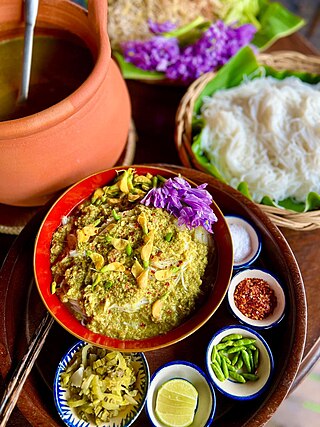
Cambodian cuisine combines the culinary traditions of many different ethnic groups in Cambodia, an important subset of which is Khmer cuisine, the nearly-two-thousand-year-old culinary tradition of the majority Khmer people. Over centuries, Cambodian cuisine has incorporated elements of Indian, Chinese, Portuguese and French cuisine, and due to some of these shared influences and mutual interaction, it has many similarities with the cuisines of Central Thailand, and Southern Vietnam and to a lesser extent also Central Vietnam, Northeastern Thailand and Laos.

Nouvelle cuisine is an approach to cooking and food presentation in French cuisine. In contrast to cuisine classique, an older form of haute cuisine, nouvelle cuisine is characterized by lighter, more delicate dishes and an increased emphasis on presentation. It was popularized in the 1960s by the food critic Henri Gault, who invented the phrase, and his colleagues André Gayot and Christian Millau in a new restaurant guide, the Gault-Millau, or Le Nouveau Guide.

Samlor machu is a Khmer term for a category of sour soups.

Heston Marc Blumenthal is an English celebrity chef, TV personality and food writer. Blumenthal is regarded as a pioneer of multi-sensory cooking, food pairing and flavour encapsulation. He came to public attention with unusual recipes, such as bacon-and-egg ice cream and snail porridge. His recipes for triple-cooked chips and soft-centred Scotch eggs have been widely imitated. He has advocated a scientific approach to cooking, for which he has been awarded honorary degrees from the universities of Reading, Bristol and London and made an honorary Fellow of the Royal Society of Chemistry.

James Martin is a British chef and television presenter, best known for his television work with the BBC and ITV.

Nataing or Khao Tang Na Tang is a Cambodian and Thai style red pork curry dip. It is a creamy ground pork dish cooked in coconut milk, often served with rice cakes.

Corn fritters are fried cakes of a dough or batter made of, or containing a featured quantity of maize (corn). Originating in Native American cuisine, they are a traditional sweet and savory snack in the Southern United States, as well as Indonesia where they are known as perkedel jagung or bakwan jagung.

Kroeung is a generic Khmer word for a number of spice/herb pastes that make up the base flavors of many Khmer dishes. Such dishes are often dubbed with the "-kroeung" suffix. Kroeung is traditionally made by finely chopping the ingredients and grinding them together using a heavy mortar and pestle although mechanical food processors can be used in modern kitchens. Various ingredients, depending on the dish and the taste of the cook, can be pounded into kroeung. The eight most commonly used are lemongrass, magrut lime zest and leaves, galangal, turmeric, garlic, shallots, dried red chillies and various rhizomes . This herbal paste is essential for preparing Khmer dishes in order to create the authentic flavour.
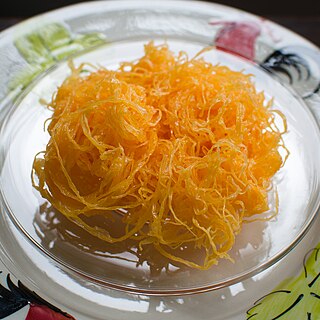
Fios de ovos is a traditional Portuguese sweet food made of eggs, drawn into thin strands and boiled in sugar syrup. They can be found in many Thai desserts; this unique dish found its way to Thailand in the 17th century. It is a traditional element in Portuguese and Brazilian cuisine, in desserts and as side dishes.
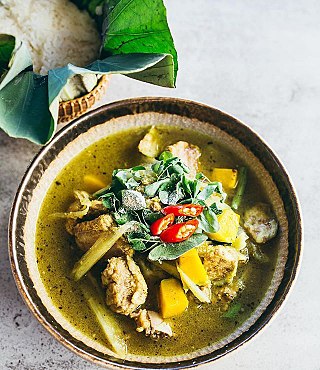
Samlor kako or Cambodian ratatouille is a traditional Cambodian soup considered one of Cambodia's national dishes. Samlar kako consists of green kroeung, prahok, roasted ground rice, catfish, pork or chicken, vegetables, fruits and herbs. The dish has been compared to French ratatouille or pot-au-feu.
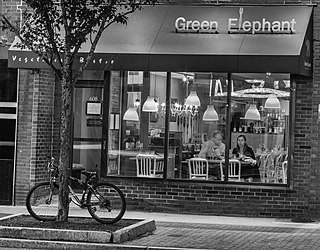
The Green Elephant Vegetarian Bistro is a vegetarian restaurant serving Thai cuisine in Portland, Maine, that opened in 2007 in the city's Arts District. A second Green Elephant restaurant is located in Portsmouth, New Hampshire. Both have received critical attention for their vegetarian dishes.
Joannès "Jo" Rivière is a French chef, restaurateur and cookbook author specializing in Cambodian cuisine. He has been regarded as the leading Western authority on Cambodian food.

Chef Nak is a Cambodian celebrity chef, culinary author, and entrepreneur.
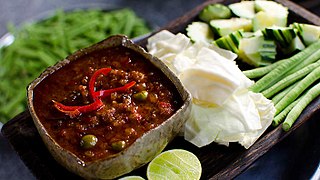
Prahok ktis is a Cambodian dipping sauce made from prahok sach, minced pork, yellow kroeung, coconut cream, tamarind water, palm sugar, pea eggplants and kaffir lime leaves. Pea eggplants can also be replaced with green apples, unripe peaches or nectarines, cabbage or cauliflower.


























